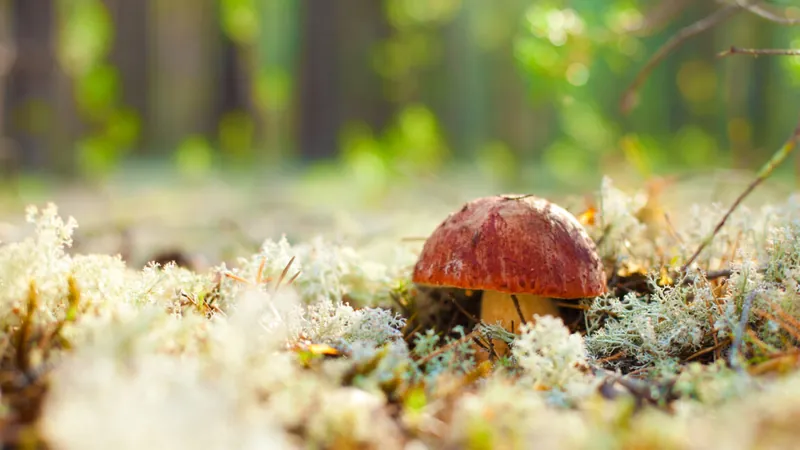
Unveiling the Secrets of Fungal Communication: Do They Think or Just Act?
2024-11-02
Author: Ming
Fungi, often overlooked in the grand tapestry of life, are far more complex than they appear. Above ground, we may see mushrooms and fruiting bodies, but hidden beneath lies a sophisticated network of filaments known as mycelium. Recent research has revealed that, despite lacking a brain, fungi may possess the ability to communicate and respond to their environment intelligently.
Researchers from Tohoku University and Nagaoka College in Japan embarked on an intriguing exploration of how fungi might recognize and navigate food sources. They focused on Phanerochaete velutina, a fungus that thrives on decaying wood, conducting experiments to understand how its mycelial network responds to food arranged in various configurations.
The findings were fascinating: the mycelial network demonstrated distinct growth patterns according to the arrangement of wood blocks, suggesting that these organisms communicate with one another to optimize nutrient absorption. As the researchers highlighted in their study published in Fungal Ecology, this capability indicates that fungi can process spatial information and alter their growth behavior accordingly.
The Experiment
To delve deeper into this phenomenon, scientists soaked wood blocks in water and then allowed P. velutina to colonize them before placing these blocks in damp soil, each set arranged either in a circle or an X shape. After an incubation period of 116 days, observation revealed significant differences in the fungus's development.
While initially, there wasn’t much variance in hyphal coverage between the arrangements, over time, notable distinctions emerged. In the circle formation, fungal growth was evenly distributed, whereas the X arrangement revealed heightened decay activity in the four outermost blocks. This led researchers to theorize that these blocks served as "outposts," likely benefiting from increased hyphal connections that facilitated better foraging for nutrients.
The Mechanism of Communication
The growth pattern of fungal mycelium is referred to as acropetal growth, meaning it typically expands outward. However, the study found that over time, the hyphae began to prioritize growth in directions that yielded the greatest nutrient availability, indicating a form of communication likely driven by electric signals traveling through the mycelial network.
Interestingly, the mycelium's behavior became even more intriguing when taking into account the equal distribution of nutrients across the experimental setup. Despite having similar resources available, the strongest hyphal connections were still seen on the X’s outer blocks, hinting at a more complex and somewhat mysterious communication process at play. Researcher Yu Fukasawa speculates that fungi are signaling one another about nutrient-rich areas, potentially prioritizing growth to expand their colonies rather than simply consuming what’s directly available.
Implications and Future Research
This study contributes to a growing body of evidence suggesting that fungi may demonstrate forms of cognition—the ability to process information at a cellular level reminiscent of simpler brain functions found in higher organisms. Such findings raise intriguing questions about the nature of consciousness and decision-making in beings traditionally viewed as simple life forms.
While fungi do not possess thoughts as we understand them in more complex creatures, the implications of their networking capabilities are profound. Their capacities could eventually lead to breakthroughs in understanding ecological interactions and fungal roles in decomposing ecosystems, or even in discovering new ways to utilize fungi in biotechnology and medicine.
As researchers continue to delve into the depths of fungal behavior, one thing remains clear: fungi are more than just background players in our environments; they are communicative, responsive, and intricately woven into the fabric of our ecosystems. Let's remain curious about these remarkable organisms—who knows what secrets they might reveal next?
Published in Fungal Ecology, 2024. DOI: 10.1016/j.funeco.2024.101387



 Brasil (PT)
Brasil (PT)
 Canada (EN)
Canada (EN)
 Chile (ES)
Chile (ES)
 España (ES)
España (ES)
 France (FR)
France (FR)
 Hong Kong (EN)
Hong Kong (EN)
 Italia (IT)
Italia (IT)
 日本 (JA)
日本 (JA)
 Magyarország (HU)
Magyarország (HU)
 Norge (NO)
Norge (NO)
 Polska (PL)
Polska (PL)
 Schweiz (DE)
Schweiz (DE)
 Singapore (EN)
Singapore (EN)
 Sverige (SV)
Sverige (SV)
 Suomi (FI)
Suomi (FI)
 Türkiye (TR)
Türkiye (TR)